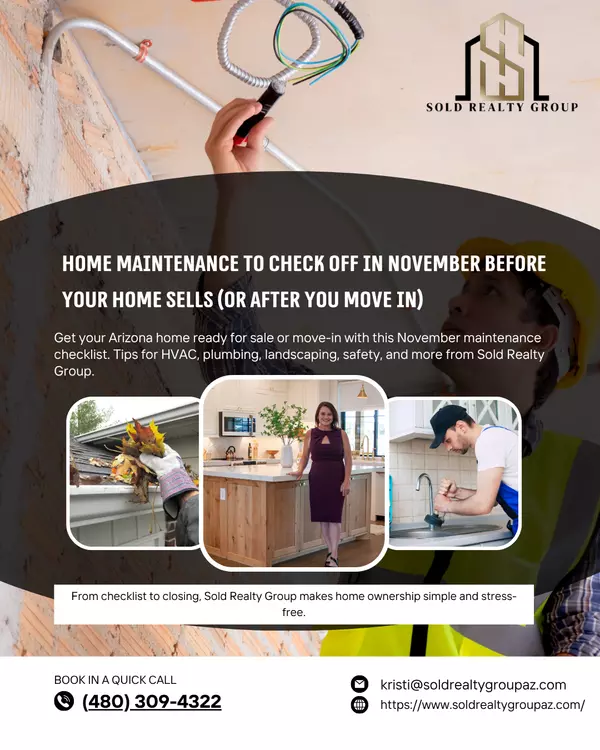
Flipping homes can be a profitable venture, especially in Arizona's dynamic real estate market. With booming cities, diverse communities, and a high demand for updated homes, the state presents excellent opportunities for investors. However, not every property will turn a profit—successful flipping requires finding the right property in the right location, making cost-effective upgrades, and keeping a close eye on local market trends. Here’s a guide to identifying a good flip in Arizona.
1. Up-and-Coming Neighborhoods
Location is one of the most critical factors in a profitable flip, and in Arizona, this means targeting up-and-coming neighborhoods with high growth potential.
What to Look For:
- Signs of Revitalization: Look for areas where the local government or private developers are investing in infrastructure, parks, schools, or commercial spaces. Neighborhoods undergoing revitalization often see property values rise as the area becomes more desirable.
- Emerging Hotspots: In cities like Phoenix, Mesa, and Scottsdale, areas near new transportation links, trendy restaurants, or tech hubs often see rapid appreciation. Stay updated on local development plans and community projects that indicate future growth.
- Close to Amenities: Arizona buyers appreciate easy access to shopping, dining, and recreation. Neighborhoods near entertainment districts or outdoor activities (like hiking trails) tend to attract attention, especially from younger buyers and families.
Examples:
- Central Phoenix: Areas like Encanto Village and Garfield District are experiencing a resurgence, attracting younger buyers and urban professionals who want to be close to downtown.
- Mesa: With rapid growth and a thriving downtown, Mesa’s neighborhoods near the light rail are becoming more popular, making them good options for flippers.
- South Scottsdale: Known for its proximity to entertainment and dining, South Scottsdale remains a desirable area for both flippers and buyers, with strong potential for return on investment.
2. Property Condition and Potential for Cost-Effective Upgrades
When flipping, it’s essential to find properties that require mostly cosmetic upgrades rather than extensive repairs, as this can keep costs low and maximize profitability.
What to Look For:
- Solid Structure: Look for homes with good “bones,” including a sound roof, solid foundation, and functioning HVAC systems. Structural issues can be costly, so it’s usually best to avoid properties with major foundational problems.
- Cosmetic Fixer-Uppers: Properties that need mostly aesthetic improvements, like fresh paint, new flooring, and updated fixtures, are ideal. Kitchens and bathrooms, in particular, offer a high return on investment, especially when given modern updates like energy-efficient appliances, quartz countertops, or new cabinetry.
- Energy-Efficiency Potential: Arizona buyers value energy efficiency due to the state’s warm climate. Adding energy-efficient windows, better insulation, or smart thermostats can add value without breaking the bank.
Tips for Cost-Effective Upgrades:
- Prioritize kitchens and bathrooms, as these areas provide the best returns.
- Use desert-friendly landscaping, such as xeriscaping, which is affordable, low-maintenance, and appealing to Arizona buyers.
- Upgrade to energy-efficient appliances and fixtures, as these additions tend to be a selling point in Arizona’s hot climate.
3. Current Market Trends
Real estate markets fluctuate, so it’s crucial to stay informed about current trends and buyer preferences. In Arizona, factors like population growth, interest rates, and seasonal demand can all impact the profitability of a flip.
Key Trends:
- Population Growth: Arizona cities, particularly Phoenix and surrounding areas, have seen steady population growth. This demand drives property values up and creates a large pool of potential buyers for flippers.
- Interest Rates: Keep an eye on interest rates, as lower rates generally encourage more home purchases. Although this is true nationally, Arizona’s relatively affordable cost of living makes the state particularly attractive when rates are favorable.
- Shift Toward Updated Homes: Buyers are increasingly looking for move-in-ready homes, especially those with modern amenities and stylish finishes. Flipping homes with on-trend designs and updated features, like open floor plans and energy-efficient appliances, can attract a larger buyer pool.
Tip: Pay attention to Arizona-specific buyer preferences, such as modern Southwestern-style décor, energy-efficient features, and open indoor-outdoor living spaces that accommodate the warm climate.
4. Seasonal Timing
Arizona’s real estate market can have seasonal fluctuations, so timing your flip can be important for maximizing profit. In many Arizona areas, the best selling season is in the spring, when temperatures are milder, and there’s a larger pool of buyers.
Best Times to Sell:
- Spring (March to May): Spring is the prime time for selling, as buyers are more active when the weather is pleasant. Preparing a flip to list during this season can result in quicker sales and potentially higher offers.
- Early Fall (September to October): Early fall is another good time to list, especially in Arizona where the fall weather is still mild. However, avoid the late summer months, as high temperatures tend to dampen buyer activity.
Tip: Plan your renovation schedule to ensure the property is ready for listing during these peak seasons. Properties listed in the fall or winter may sit on the market longer, impacting profit margins.
5. Exit Strategy and Profit Margins
Understanding your target profit margin and having a clear exit strategy are essential to any successful flip.
What to Consider:
- Target Profit Margin: Many flippers aim for a return of at least 10-20% of the property’s resale value. To calculate this, assess the purchase price, renovation costs, holding costs, and anticipated sale price.
- Market Comparisons: Research comparable properties (comps) to determine how much similar homes are selling for in the area. This will give you a realistic idea of what you can list the property for post-renovation.
- Holding Costs: Consider property taxes, insurance, and any HOA fees if applicable. Holding costs can add up if the property takes longer to sell than anticipated, so aim to flip in a timely manner to maximize profit.
Tip: Working with a real estate agent who specializes in investment properties can provide valuable market insights and help you better estimate costs and potential profits.
Final Thoughts
Arizona offers a wealth of opportunities for real estate flippers, thanks to its booming population, diverse neighborhoods, and consistent demand for updated homes. By focusing on properties in promising neighborhoods, prioritizing cost-effective upgrades, staying attuned to market trends, and timing your sale strategically, you can maximize your chances of a successful flip in Arizona. With the right approach, flipping homes in the Grand Canyon State can be a profitable and rewarding investment.
Remember, successful flipping isn’t just about quick renovations but also about understanding the local market and making strategic choices that appeal to Arizona buyers. Whether you’re a seasoned investor or just getting started, keeping these factors in mind can help guide you toward a profitable and stress-free flipping experience.












